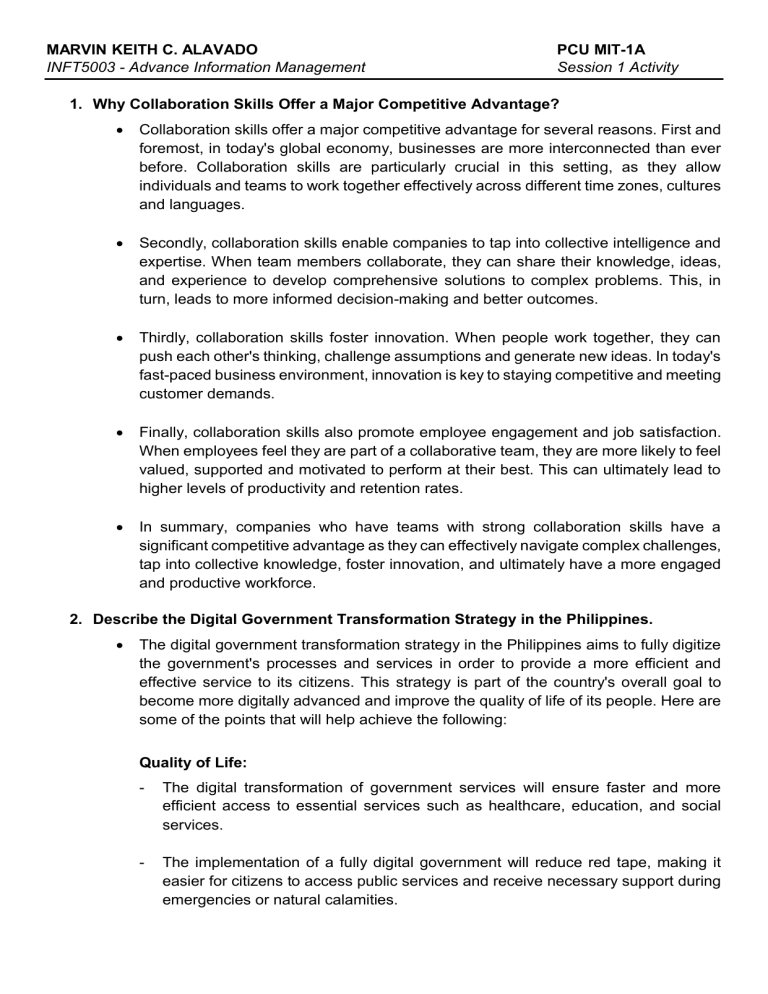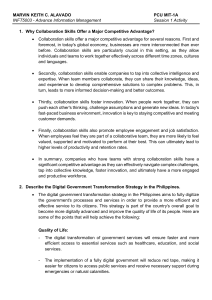Session 1 Activity - Advance Information Management MARVIN KEITH C ALAVADO
advertisement

MARVIN KEITH C. ALAVADO INFT5003 - Advance Information Management PCU MIT-1A Session 1 Activity 1. Why Collaboration Skills Offer a Major Competitive Advantage? Collaboration skills offer a major competitive advantage for several reasons. First and foremost, in today's global economy, businesses are more interconnected than ever before. Collaboration skills are particularly crucial in this setting, as they allow individuals and teams to work together effectively across different time zones, cultures and languages. Secondly, collaboration skills enable companies to tap into collective intelligence and expertise. When team members collaborate, they can share their knowledge, ideas, and experience to develop comprehensive solutions to complex problems. This, in turn, leads to more informed decision-making and better outcomes. Thirdly, collaboration skills foster innovation. When people work together, they can push each other's thinking, challenge assumptions and generate new ideas. In today's fast-paced business environment, innovation is key to staying competitive and meeting customer demands. Finally, collaboration skills also promote employee engagement and job satisfaction. When employees feel they are part of a collaborative team, they are more likely to feel valued, supported and motivated to perform at their best. This can ultimately lead to higher levels of productivity and retention rates. In summary, companies who have teams with strong collaboration skills have a significant competitive advantage as they can effectively navigate complex challenges, tap into collective knowledge, foster innovation, and ultimately have a more engaged and productive workforce. 2. Describe the Digital Government Transformation Strategy in the Philippines. The digital government transformation strategy in the Philippines aims to fully digitize the government's processes and services in order to provide a more efficient and effective service to its citizens. This strategy is part of the country's overall goal to become more digitally advanced and improve the quality of life of its people. Here are some of the points that will help achieve the following: Quality of Life: - The digital transformation of government services will ensure faster and more efficient access to essential services such as healthcare, education, and social services. - The implementation of a fully digital government will reduce red tape, making it easier for citizens to access public services and receive necessary support during emergencies or natural calamities. MARVIN KEITH C. ALAVADO INFT5003 - Advance Information Management - PCU MIT-1A Session 1 Activity The virtualization of government transactions will result in faster processing of important documents and fewer trips to government offices, which will greatly reduce the time and cost involved in dealing with government agencies. Economic Growth: - The digitalization of government services will create an environment conducive to investment and business growth. - The implementation of e-payments and online transaction platforms will simplify and speed up the processing of business permits and licenses. - The use of Big data analytics to drive decisions can help businesses gain insights into consumer preferences and trends, enabling them to innovate and develop new products and services. Business Potential: - The shift towards digital government services will generate new business opportunities for technology companies. - The digitalization of government processes will open up avenues for innovation in public sector services, thus creating new service providers within the government ecosystem. - The creation of open data platforms and other data sharing initiatives will spur innovation and business growth in the private sector. Public Service Delivery: - The implementation of a digital government will improve public service delivery by streamlining the government's processes and eliminating the need for paper-based transactions. - The use of digital technologies in public service delivery will speed up processes and enhance transparency and accountability in government transactions. - It will democratize service access by making public services available to citizens regardless of their location. Generally, the digital transformation strategy is geared towards making the government more efficient, effective, transparent, and accountable in delivering public services to the people. This will result in a better quality of life, economic growth, business potential, and improved public service delivery. MARVIN KEITH C. ALAVADO INFT5003 - Advance Information Management PCU MIT-1A Session 1 Activity 3. What technologies are driving Industry 4.0? Explain each briefly. Internet of Things (IoT): This technology enables the connection of devices, machines, sensors, and other objects with the internet to collect and exchange data, enabling automated and intelligent decision-making. Big Data and Analytics: Industry 4.0 generates a vast amount of data, which requires sophisticated tools for processing, analysing, and deriving insights that enable better decision-making. Artificial Intelligence (AI): The use of AI enables machines to mimic human intelligence, providing them with the ability to learn from their experiences, make decisions, and interact with humans in natural language. Robotics: Robots have been used in industry for decades, but Industry 4.0 has seen the emergence of advanced robotics with sensors, actuators, and AI capabilities, enabling them to carry out complex tasks with greater efficiency and precision. Cybersecurity: As more devices become connected to the internet, there is an increased risk of cyber-attacks. Industry 4.0 technologies such as blockchain and secure communication protocols help to ensure the security of data and systems. Cloud Computing: This technology enables the storage, processing, and sharing of data over a network of remote servers rather than on a local computer, making it possible to access data from anywhere at any time. Additive Manufacturing: Also known as 3D printing, this technology enables the creation of complex and customized objects from digital designs, providing manufacturers with greater flexibility and reducing the need for physical inventory.






